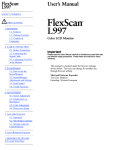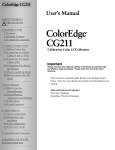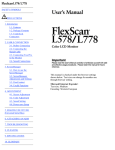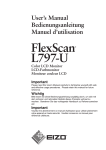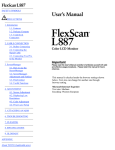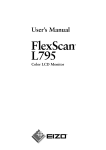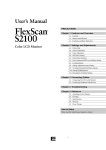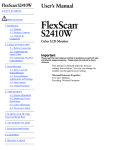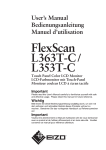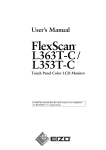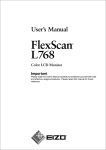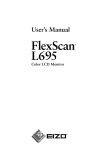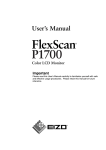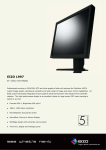Download ADC L997 User's Manual
Transcript
SAFETY SYMBOLS
PRECAUTIONS
1. Introduction
1-1. Features
1-2. Package Contents
1-3. Controls &
Connectors
2. CABLE CONNECTION
2-1. Before Connecting
2-2. Connecting the
Signal Cable
2-3. Connecting Two PCs
to the Monitor
3. ScreenManager
3-1. How to use the
ScreenManager
3-2. ScreenManager
Adjustments and Settings
3-3. FineContrast
3-4. Useful Functions
4. ADJUSTMENT
4-1. Screen Adjustment
4-2. Displaying Low
Resolutions
4-3. Color Adjustment
4-4. Power-save Setup
5. ActiveShot Function
5-1. Operation
5-2. Sub Window Settings
5-3. Settings using the
Control Buttons
6. ActiveRotationII Function
7. MAKING USE OF USB
(Universal Serial Bus)
8. ATTACHING AN ARM
This manual is checked under the browser settings
shown below. Text size can change for another one
through browser setting.
Microsoft Internet Exproler:
Text size: Medium
Encoding: Western European
9. TROUBLESHOOTING
10. CLEANING
11. SPECIFICATIONS
12. GLOSSARY
APPENDIX/ANHANG/ANNEXE
About TCO'03 (Applicable gray)
About TCO'99 (Applicable black)
FCC Declaration of Conformity
Hinweis zur Ergonomie / Recycle
Auskunft / Hinweise zur Auswahl
des richtigen Schwenkarms für
Ihren Monitor
SAFETY SYMBOLS
This manual uses the safety symbols below. They denote critical information. Please read them carefully.
WARNING
Failure to abide by the information in a WARNING may result in serious injury and can be life
threatening.
CAUTION
Failure to abide by the information in a CAUTION may result in moderate injury and/or property
or product damage.
Indicates a prohibited action.
Indicates to ground for safety.
Copyright© 2004-2005 EIZO
NANAO CORPORATION All rights reserved. No part of this manual may be reproduced, stored in a
retrieval system, or transmitted, in any form or by any means, electronic, mechanical, or otherwise, without
the prior written permission of EIZO NANAO CORPORATION.
EIZO NANAO CORPORATION is under no obligation to hold any submitted material or information
confidential unless prior arrangements are made pursuant to EIZO NANAO CORPORATION's receipt of
said information. Although every effort has been made to ensure that this manual provides up-to-date
information, please note that EIZO monitor specifications are subject to change without notice.
ENERGY STAR is a U.S. registered
mark.
Apple and Macintosh are registered trademarks of Apple Computer, Inc.
VGA is a registered trademark of International Business Machines Corporation.
DPMS is a trademark and VESA is a registered trademark of Video Electronics Standards Association.
Windows is a registered trademark of Microsoft Corporation.
PowerManager is a trademark of EIZO NANAO CORPORATION.
ScreenManager, FlexScan and EIZO are registered trademarks of EIZO NANAO CORPORATION.
As an ENERGY STAR® Partner, EIZO NANAO CORPORATION has determined that this product
meets the ENERGY STAR guidelines for energy efficiency.
1. Introduction
Thank you very much for choosing an EIZO Color Monitor.
1-1. Features
●
●
●
Dual inputs compliant (DVI-I x 2)
DVI Digital input (TMDS) compliant
[Horizontal scanning frequency]
Analog: 24 - 100 kHz
Digital: 31 - 100 kHz
[Vertical scanning frequency]
Analog: 49 - 86 Hz (1600 x 1200: 49 - 76 Hz)
Digital: 59 - 61 Hz (VGA text: 69 - 71 Hz)
●
[Resolution] 1600 dots x 1200 lines
Smoothing function incorporated for the adjustment of an enlarged image
●
FineContrast modes, to select the most suitable mode for screen display
●
ActiveShot (Picture in Picture) function incorporated.
●
●
●
●
ActiveRotationII (changing the display orientation of the monitor with the panel rotation) function
incorporated.
The utility software "ScreenManager Pro for LCD" (for Windows) which can control the monitor
from a PC with a mouse or keyboard is included (refer to the EIZO LCD Utility Disk).
The height adjustable stand incorporated
Ultra slim bezel incorporated
1-2. Package Contents
Please contact your local dealer for assistance if any of the listed items are missing or damaged.
● LCD Monitor
● EIZO LCD Utility Disk
● Power Cord
● User's Manual (in the CD-ROM)
● Signal Cable (FD-C39)
● Setup Guide
● Signal Cable (FD-C16)
● ScreenManager Quick Reference
● EIZO USB Cable (MD-C93)
● LIMITED WARRANTY
●
●
Please retain the packing materials for future transference.
The "ActiveRotationII Utility" (for Windows) is included in the EIZO LCD Utility Disk. Please refer
to the readme.txt in the EIZO LCD Utility Disk for the details.
1-3. Controls & Connectors
Front
(1) ScreenManager ®
(2) Main Power Switch
(3) Input Signal Selection Button
(4) Auto Adjustment Button
(5) Enter Button
(6) Control Buttons* 1 (Left, Down, Up, Right)* 2
(7) Power Button
(8) Power Indicator* 3
Blue
Operation
Yellow
Power saving
Flashing yellow slowly Power is off (Main power is on)
Off
Power off
*1 Directly pressing the control button without using the ActiveShot function allows you to select a
FineContrast mode. The ScreenManager Main Menu and the FineContrast Menu cannot be displayed at
the same time.
*2 These buttons are changed to Up, Left, Right, Down when using the monitor with portrait mode.
*3 Blue lighting, when the screen is displayed (Operation mode), is made to non-light, See Power
Indicator.. Regarding the power indicator for the "Off Timer".
Rear
(9) Height Adjustable Stand (Detachable)* 4
(10) Security Lock Slot* 5
(11) DVI-I Input Connector x 2 (SIGNAL 1/SIGNAL 2)
(12) USB Port (1 Upstream)
(13) USB Port (2 Downstream)
(14) Power Connector
*4 The LCD monitor has the capability of the Portrait/Landscape display (The panel pivots in the
clockwise direction 90° (See ActiveRotationII Function.)).
The LCD monitor can be used with an optional arm stand by removing the stand (See ATTACHING
AN ARM.).
*5 Allows for connection of a security cable. This lock supports Kensington's MicroSaver
security system. For further information, please consult:
Kensington Technology Group
2855 Campus Drive, San Mateo, CA 94403 USA
Tel.: 800-650-4242, x3348, Intl: 650-572-2700, x3348
Fax: 650-572-9675
http://www.kensington.com
2. CABLE CONNECTION
2-1. Before Connecting
Before connecting your monitor to the PC, change the display screen settings (Resolution and frequency) in
accordance with the APPENDIX charts.
●
When your computer and display support VESA DDC, the suitable resolution and the refresh rate are
set by just plugging your display into the computer without any manual settings.
2-2. Connecting the Signal Cable
●
Be sure that the power switches of both the PC and the monitor are OFF.
1. Plug the signal cable into the connector at the rear of the monitor and the other end of
the cable into the video connector on the PC.
After connecting, secure the connection with the screw-in fasteners.
Analog Input
Signal Cable
Signal Cable
(FD-C16 enclosed)
Signal Cable (FD-C16 enclosed) + Macintosh Adapter
(Optional)
Connector of the
PC
Video Output
Connector / D-Sub
mini 15 pin
Input Connector
(monitor) / DVI
Video Output
Connector / D-Sub
15 pin
Input Connector
(monitor) / DVI
PC
●
●
●
Standard graphics card
Power Macintosh G3
(Blue & White) / Power
Mac G4 (VGA)
Macintosh
Digital Input
Signal Cable
Signal Cable
(FD-C39 enclosed)
●
Connector of the PC
Video Output
Connector / DVI
Input Connector
(monitor) / DVI
PC
●
●
Digital Graphics board
Power Mac G4/G5 (DVI)
The monitor is not compatible with a Power Mac G4/G5 ADC (Apple Display Connector).
2. Plug the power cord into the power connector on the rear of the monitor.
3. Lead the power cord and signal cable into the cable holder at rear of the monitor.
●
●
When housing the cables into the cable holder, lead them to the cable entrance side and pinch the
projection to open the cable entrance.
The cables are recommended to lead with slight sag for the smooth motion of the stand and the
Portrait/Landscape display.
4. Plug the other end of the power cord into a power outlet.
Use the enclosed power cord and connect to the standard power outlet of your
country.
Be sure to remain within the rated voltage of the power cord. Not doing so may
result in fire or electric shock.
The equipment must be connected to a grounded main outlet.
Not doing so may result in fire or electric shock.
5. Turn on the monitor's Power button and then turn on the PC's power.
The monitor's power indicator will light up (blue).
If an image does not appear, refer to the " 9. TROUBLESHOOTING" for advice.
Whenever finished, turn off the PC and the monitor.
●
●
●
When turning on the monitor, the kind of the input signal (Signal1 or 2/Analog or Digital) is displayed
for a few seconds on the right top corner of the screen.
Adjust brightness of the screen depending on the brightness of your environment. Too dark or too
bright of a screen can cause eyestrain.
Be sure to take adequate rests. A 10-minute rest period each hour is suggested.
6. When using the monitor in portrait style, refer to the "6. ActiveRotationII Function".
7. When using the software, ScreenManager Pro for LCD (for Windows), connect the
upstream port of the monitor to the downstream port of the USB compliant PC or
another hub with the USB cable.
After connecting the USB cable, the USB function can be set up automatically. For further details about the
"ScreenManager Pro for LCD", refer to the readme.txt in the CD-ROM.
2-3. Connecting Two PCs to the Monitor
Two PCs can be connected to the monitor through the Signal 1 and the Signal 2 on the back of the monitor.
Connecting Examples
PC 1
PC 2
D-Sub Signal Cable
(Ex.1) Analog mini 15 (FD-C16 enclosed)
pin
Signal Cable
(FD-C39 enclosed)
D-Sub Signal Cable
(Ex.2) Analog mini 15 (FD-C16 enclosed)
pin
Signal Cable
(FD-C16 optional)
Signal Cable
(FD-C39 enclosed)
Signal Cable
(FD-C39 optional)
(Ex.2) Digital DVI
DVI
Analog
D-Sub
mini Analog
15 pin
DVI
Digital
Selecting the Active Input
The Input Signal Selection Button on the control panel can be used to select either SIGNAL 1 or SIGNAL
2 as the active input at any time. Every time the button is pressed, the input changes. When switching the
signal, the kind of the input signal (Signal1 or 2/Analog or Digital) is displayed for a few seconds on the
right top corner of the screen.
●
●
When pressing the input signal selection button for 2 seconds, the ActiveShot function will be
available. (The sub window will appear. Refer to 5. ActiveShot Function)
When using the ActiveShot function, slightly pressing the Input signal selection button switches the
image of the Main window and the Sub window.
The Priority Input Signal
This function is used to select which PC will have priority to control the monitor when utilizing two PCs.
The monitor constantly checks the input signals and switches automatically in accordance with the "Input
Priority" setting (see table below). Once a priority is set, whenever a change of signal is detected at the
selected input, the monitor will switch the input to that signal.
In the case of only one signal being present at either input, the monitor automatically detects and displays
that signal.
Priority setting
Performance
1
(SIGNAL 1)
If signals from both inputs are present, the monitor gives preference to Signal 1 in the following
cases.
● When the power of the monitor is turned ON.
● When the signal input to Signal 1 is changed even if active input was Signal 2.
2
(SIGNAL 2)
If signals from both inputs are present, the monitor gives preference to Signal 2 in the following
cases.
● When the power of the monitor is turned ON.
● When the signal input to Signal 2 is changed even if active input was Signal 1.
Manual
The monitor will not detect signals automatically in this mode. Select the active input by
pressing the Input Signal Selection Button on the monitor's control panel.
●
When the "1" or "2" is selected, the power saving mode of the monitor activates only if both PCs are in
power saving mode.
3. ScreenManager
3-1. How to use the ScreenManager
ScreenManager allows you to adjust screen performance though the main menu and select a FineContrast
mode easily.
●
Main Menu and FineContrast Menu cannot be activated at the same time.
1. Entering the ScreenManager
Press the Enter button once to display the main menu of the ScreenManager.
2. Making Adjustments and Settings
1. Select the desired sub menu icon using the Control buttons and press the Enter button. The sub menu
appears.
2. Use the Control buttons to select the desired setting icon and press the Enter button. The setting menu
appears.
3. Use the Control buttons to make all required adjustments and press the Enter button to save the settings.
3. Exiting the ScreenManager
1. To return to the main menu, select the <Return> icon or press the Down button twice, followed by the
Enter button.
2. To exit the ScreenManager, select <Exit> icon or press the Down button twice, followed by the Enter
button.
●
Double clicking the Enter button at any time also exits the ScreenManager menu.
FineContrast Menu
Directly pressing the left or right button allows you to select the best suited mode for screen display from
6 FineContrast modes; Custom, Movie, Picture, Text , External and sRGB. To exit the menu, press the
Enter button.
3-2. ScreenManager Adjustments and Settings
The following table shows all the ScreenManager's adjustment and setting menus.
"*" indicates adjustments of analog input only and "**" indicates digital input only.
Main menu
Screen
Sub menu
Reference
Clock
*
Phase
*
Position
*
Resolution
* 4-1. Screen Adjustment
Range Adjustment
*
Smoothing
Signal Filter
*
Brightness
Temperature
Gamma
Color
(Custom)* 1
Saturation
4-3. Color Adjustment
Hue
Gain
6 Colors
Reset
Standard
5. ActiveShot Function
Picture in Picture Clip
Off
Power
Manager
DVI DMPM
**
VESA DPMS
* 4-4. Power-save Setup
Off
Screen Size
4-2. Displaying Low Resolutions
Border Intensity
Input Priority
Select the priority input signal.
Off Timer
Set the monitor's off timer to on or off.
Beep
Set the monitor's beeper to on or off.
Others
Menu Settings
Menu Size
Change the size of the menu.
Menu Position
Adjust the menu position.
Menu Off Timer
Set the menu displaying time.
Translucent
Set the transparency of the background.
ActiveRotationII
6. ActiveRotationII Function.
Power Indicator
Make non-light for blue lighting when
the screen is displayed.
Reset
Return to the factory default settings.
Information
Information
Review the ScreenManager's settings,
model name, serial number and usage
time.* 2
Language
English, German, French, Spanish, Italian,
Swedish and Japanese
Select the ScreenManager's language.
*1 The adjustable functions on the <Color> menu depend on the selected FineContrast mode. The above
table shows the sub menus when the "Custom" mode is selected (See "4-3. Color Adjustment").
*2 Due to the inspection on the factory, the usage time may not "0 hour" at shipping.
3-3. FineContrast
This function allows you to select the best suited mode for screen display.
To select the Mode
Directly pressing the control button without using the ActiveShot function allows you to select the best
suited mode for screen display from 6 FineContrast modes; Text, Picture, Movie, sRGB, Custom and
External. Color settings each mode can be adjusted by using the <Color> menu of the ScreenManager.
●
When the main menu of ScreenManager is displayed on the screen, the FineContrast Menu cannot be
activated.
Exit
Press the Enter button to exit the menu.
FineContrast Mode
Selectable FineContrast modes are as follows.
Custom To adjust the color settings according to your preference
Movie
Animated images
Picture
Photo or picture image
Text
Text on word processor or spreadsheet software
External
Color reproduction by setting the values of color coordinate and gamma with using the "ScreenManager
Pro for LCD (for Windows)" (Refer to the EIZO LCD Utility Disk.)
sRGB
To display the screen images based on those original colors (ex. over the Internet)
Color Adjustment of the Mode Settings
<Brightness>, <Temperature>, <Gamma> and <Contrast> settings can be adjusted on the FineContrast
Menu. Select the desired function icon with the Up/Down control buttons and adjust with the Left/Right
buttons. (Setting(s) of <Temperature> and/or <Gamma> is defined as standard default in some modes. (See
"4-3. Color Adjustment"))
Detailed Adjustments
The detailed color settings of each mode can be adjusted by using the <Color> menu of the
ScreenManager. (See "4-3. Color Adjustment")
3-4. Useful Functions
Adjustment Lock
Use the "Adjustment Lock" function to prevent any accidental changes.
●
Locked function
●
●
Unlocked function
●
●
Adjustments and settings in the ScreenManager
Auto adjustment button adjustments
Selecting of the FineContrast mode by the control buttons / Adjustments
Input signal selection button
Power Button
[How To lock]
1. Turn off the monitor's power by the Power button on the control panel.
2. Press on the Auto Adjustment button while switching on the monitor's power.
[How To unlock]
1. Turn off the monitor's power by the Power button on the control panel.
2. Hold down the Auto Adjustment button once again and turn the power back on.
Off Timer
The off timer function causes the monitor to automatically enter a power off state after a predetermined
amount of time has lapsed. This function was created to reduce Afterimage characteristics that are
particular to LCD monitors when the monitor screen is left on for a long period without use.
[Procedure]
1. Select <Off Timer> in the ScreenManager <Others> menu.
2. Select "Enable" and press the Right and Left buttons to adjust the "On Period" (1 to 23 hours).
[Off Timer System]
PC
On Period (1H - 23H)
Last 15 min. in "On period"
"On period" expired
Monitor
Operation
Advance Notice*
1
Power Off
Power Indicator
Blue
Blue Flashing
Flashing yellow slowly
*1 Advance notice (Power Indicator flashing blue) will be given 15 minutes before the monitor
automatically enters the "Power Off" mode. To delay entering the "Power Off" mode, press the Power
button during the advance notice period. The monitor will continue to operate for an additional 90
minutes.
[Power Resumption Procedure]
Press the Power button to return to a normal screen.
●
The off timer function works while the PowerManager is active, but there is no advance notice before
the monitor's power is turned off.
Power Indicator Setting
Light off the power indicator. This function is available for the multiple panels settings.
[Procedure]
1. Select <Power Indicator> in the ScreenManager <Others> menu.
2. Select "Disable".
EIZO Logo Appearing Function
When switching on the Power button on the control panel, the EIZO logo is displyed for a while. If you
desire to display or undisplay this logo, use this function. (Default is logo appearing.)
[To undisplay]
Turn off the monitor's power by the Power button, then hold down the Enter button once again and turn the
power back on.
[To display]
Turn off the monitor's power by the Power button, then hold down the Enter button once again and turn the
power back on.
4. ADJUSTMENT
4-1. Screen Adjustment
●
Allow the LCD monitor to stabilize for at least 20 minutes before making image adjustments.
The monitor displays the digital input image correctly based on its pre-setting data.
Analog Input
Screen adjustments for the LCD monitor should be used in suppressing screen flickering and also for
adjusting the screen to its proper position. There is only one correct position for each display mode. It is
also recommended to use the ScreenManager function when first installing the display or whenever
changing the system. For convenience, an easy set-up Program installed on the utility disk to assist in the
set-up procedure is provided.
Adjustment Procedure
1. Press the Auto Adjustment button on the control panel.
The message "Your setting will be lost, if you press again now." appears and remains on the screen for 5
seconds. While the message is on the screen, press the Auto Adjustment button again to automatically
adjust the clock, phase, screen position and resolution. If you do not wish to do adjust the screen, do not
press the Auto Adjustment button again.
●
The Auto adjustment function is intended for use on the Macintosh and on AT-compatible PC
running Windows. It may not work properly in either of the following cases.
When running an AT-compatible PC on MS-DOS (Not windows). The background color for the
"wall paper" or "desktop" pattern is set to black.
If the appropriate screen cannot be made by using the Auto Adjustment button, adjust the screen
through the following procedures. If the appropriate screen can be made, proceed to step 4.
2. Run the "Screen Adjustment Program".
Having read the "Readme.txt" file, run the "Screen Adjustment Program" in the enclosed EIZO LCD
Utility Disk. Step by step, adjustment is provided by the wizard guide. (If using the Windows, the program
can be directly run from the menu screen of the CD-ROM.)
●
If the user's operating system has no utility disk (e.g. OS/2), we recommend setting the desktop
pattern to that as shown in the diagram on the following.
3. Adjust by using <Screen> menu in the ScreenManager.
(1) Vertical bars appear on the screen
→
Use the <Clock> adjustment.
Select the <Clock> and eliminate the vertical bars by using the Right and Left of the Control buttons.
Do not continuously press the Control buttons, as the adjustment value will change quickly and make it
difficult to locate the most suitable adjustment point.
If the horizontal flickering, blur or bars appear, proceed to <Phase> adjustment as follows.
(2) Horizontal flickering, blurring or bars appear on the screen.
→
Use the <Phase> adjustment.
Select the <Phase> and eliminate the horizontal flickering, blurring or bars by using the Right and Left
buttons.
●
Horizontal bars may not completely disappear from the screen depending on the PC.
(3) The screen position is incorrect.
→
Use the <Position> adjustment.
The correct displayed position of the monitor is decided because the number and the position of the
pixels are fixed. The <Position> adjustment moves the image to the correct position.
Select <Position> and adjust the position of the upper left corner of the image by using the Up, Down,
Right and Left buttons in order to align the screen.
If vertical bars of distortion appear after finishing the <Position> adjustment, return to <Clock>
adjustment and repeat the previously explained adjustment procedure. ("Clock" → "Phase" →
"Position")
(4) Screen image is smaller or larger than the actual screen images.
→
Use the <Resolution> adjustment.
Adjustment is needed when the input signal resolution and the resolution now being displayed are
different.
Select <Resolution> and confirm if the resolution now being displayed is the same as the input
resolution. If it is not, adjust the vertical resolution using the up and down button and adjust the
horizontal resolution using the right and left buttons.
4. Adjust the output signal range (Dynamic Range) of the signal.
→
Use the <Range Adjustment> of <Screen> menu.
This controls the level of output signal range to display the whole color gradation (256 colors).
[Procedure]
Press the Auto Adjustment button on the Control panel while displaying the <Range Adjustment> message
to automatically adjust the range. The screen blanks for a moment and adjusts the color range to display the
whole color gradation of the current output signal.
4-2. Displaying Low Resolutions
The lower resolutions are enlarged to full screen automatically. Using the <Screen Size> function in the
<Others> menu enables to change the screen size.
1. Enlarge the screen size when displaying a low resolution.
→
Select the <Screen Size>.
Select the <Screen Size> in the others menu and select the screen size by using the up and down buttons.
Menu
Function
Displays the picture on the screen in full, irrespective of the picture's resolution. Since the vertical
resolution and the horizontal resolution are enlarged at different rates, some images may appear
distorted.
Full
Displays the picture on the screen in full, irrespective of the picture's resolution. Since the vertical
Enlarged resolution and horizontal resolution are enlarged at same rates, some horizontal or vertical image may
disappear.
Normal
Displays the picture at the actual Screen resolution.
Example: Displaying 1280 × 1024
2. Smooth the blurred texts of the enlarged screen.
→
Switch the <Smoothing> setting.
Select the suitable level from 1 - 5 (Soft - Sharp).
Select <Smoothing> in the <Screen> menu and adjust by using the right and left buttons.
●
<Smoothing> is disabled when the screen is displayed in the following resolutions.
*1600 × 1200
*The image size is doubled both in horizontally and vertically to (i.e. 1600 × 1200 enlarged from
800 × 600) provide clear focus which does notrequire
this function.
3. Set the brightness of the black area surrounding the displayed image.
→
Set the <Border Intensity>.
In the <Enlarge> mode or <Full Screen> mode, the outer area (border) is usually black. Select <Border
Intensity> in the <Others> menu and adjust by using the right and left buttons.
4-3. Color Adjustment
Color settings of each FineContrast mode can be adjusted and saved by using the <Color> menu of the
ScreenManager.
In the analog input, perform the "Range Adjustment" before making the color adjustments.
During color adjustments, the FineContrast mode cannot be changed. Select the mode in advance by
using the FineContrast Mode.
Adjustment Items
The adjustable items and displayed icons on the <Color> menu depend on the selected FineContrast mode.
" * ": Settable/Adjustable " - ": Fixed at the factory
FineContrast Modes
Functions
Icons
Text Picture Movie sRGB Custom External
Brightness *
*
*
*
*
*
*
Temperature *
*
*
*
-
*
-
*
-
-
-
*
-
Saturation
*
*
*
-
*
-
Hue
*
*
*
-
*
-
Gain
-
-
-
-
*
-
6 colors
-
-
-
-
*
-
Reset
*
*
*
-
*
-
Gamma
*
* These settings can be also adjusted on the FineContrast menu.
●
●
●
Allow the LCD monitor to stabilize for at least 20 minutes before making image adjustments. (Allow
the monitor to warm up for at least 20 minutes before making adjustments.)
Performing the <Reset> of the <Color> menu returns the color settings of the selected mode to the
default settings.
The values shown in percentages represent the current level within the specific adjustment. They are
available only as a reference tool. (To create a uniform white or black screen, the percentages for each
will probably not be the same.)
Adjustment Contents
Menu
Function Descriptions
Adjustable range
To set the brightness and contrast of the screen
0 ~ 100 %
Brightness
●
Contrast Adjustment will be available only when FineContrast mode is
"Custom","Text","Picture" or "Movie".
To set the color temperature
Temperature
●
●
4,000 ~ 10,000 K
in 500 K increments (including 9,300 K).
Default setting is off (normal white)
The values shown in the Kelvin are available only as a reference tool.
Setting the temperature under 4,000 K or over 10,000 K invalidates the color temperature
setting. (The color temperature's setting turns "OFF".)
To set the gamma value
1.4 ~ 3.0
Gamma
●
Saturation
To change the saturation
●
Hue
If setting the gamma value, the using the monitor in the digital signal input is recommended.
If using the monitor in the analog input signal, set the gamma value from 1.8 to 2.2.
The <Saturation> adjustment may cause undisplayable color tone.
To change the flesh color, etc.
●
Gain
●
-100 ~ 100
Using <Hue> adjustment may not obtain proper tone reproduction.
To change each color
(red, green and blue)
●
-100 ~ 100
Setting the minimum level (-100) turns the
image to the monochrome.
0 ~ 100%
By adjusting the red, green and blue color tones
for each mode, custom colors can be defined.
Display a white or gray background image and
adjust the <Gain>.
The values shown in the percentage are available only as a reference tool.
Setting the <Temperature> invalidates the <Gain> adjustment. <Gain> setting returns to the
defaul.
6 colors
To adjust <Saturation> and <Hue> in each color Hue: -100 ~ 100
(Red, Yellow, Green, Cyan, Blue and Magenta) Saturation: -100 ~ 100
Reset
To return the color settings of the selected mode
to the default settings
4-4. Power-save Setup
Select the <Reset>.
The <PowerManager> menu in the ScreenManager enables to set the power-save setup.
●
●
Do your part to conserve energy, turn off the monitor when you are finished using it. Disconnecting the
monitor from the power supply is recommended to save energy completely.
Even if the monitor is in a power saving mode, USB compliant devices function when they are
connected to the monitor's USB (both the upstream and the downstream ports). Therefore, power
consumption of the monitor will change according to the connected devices even if the monitor is in a
power saving mode.
Analog Input
This monitor complies with the <VESA DPMS> standard and adopts a power saving method.
[Procedure]
1. Set the PC's power saving settings.
2. Select "VESA DPMS" from the <PowerManager> menu.
[Power Saving System]
PC
Monitor
Power Indicator
Operation
Operation
Blue
STAND-BY
Power saving SUSPEND Power saving
OFF
Yellow
[Power Resumption Procedure]
Operate the mouse or keyboard to return to a normal screen.
Digital Input
This monitor complies with the "DVI DMPM".
[Procedure]
1. Set the PC's power saving settings.
2. Select "DVI DMPM" from the <PowerManager> menu.
[Power Saving System]
PC
Operation
Monitor
Power Indicator
Operation
Blue
Power saving Power saving
Yellow
[Power Resumption Procedure]
Operate the mouse or keyboard to return to a normal screen.
5. ActiveShot Function
When two PCs are connected to the monitor, ActiveShot (Picture in Picture) function allows you to display
both screen images on the Main window and Sub window at the same time. About connecting two PCs to a
monitor, See Connecting Two PCs to the Monitor.
[Example]
5-1. Operation
To display/close the Sub window
ON: Press Input Signal Selection Button on the control panel for 2 seconds.
OFF: Press Input Signal Selection Button again for 2 seconds.
●
Selecting "Off" on the <Picture in Picture> menu will also close the sub window.
To switch the image of main and Sub window
Slightly pressing the Input signal selection button (Signal 1-2) switches the signal of Main window and Sub
window.
●
The ActiveShot function cannot be used in the following cases.
❍ Using ActiveRotationII function.
❍
●
Being in "External" mode of FIneContrast mode.
When using the ActiveShot function, some animated images may flicker.
5-2. Sub Window Settings
Display Mode
<Standard> and <Clip> modes are available for displaying the Sub window (refer to following figures) for
displaying the Sub window.
The mode is set on the <Picture in Picture> menu of ScreenManager.
[Example]
<Standard> Mode
Displaying the screen image in full screen with
reducing the image size.
<Clip> Mode
Displaying a certain part of the screen image without
reducing the image size.
<Standard> Mode
Displaying the screen image in full screen with reducing the image size in the Sub window. Select
<Standard> mode on <Picture in Picture> menu of ScreenManager.
To select the size
→
Select <Window Size>.
This sets the window size from "Large" (approx. 1/4), "Medium" (approx. 1/6) or "Small" (approx. 1/16).
Select the size of the Sub window.
●
After selecting the size, the actual Sub window size depends on the input signal.
To adjust the position
→
Select <Window Position>.
This adjusts the position of the Sub window.
Select <Window Position> and adjust the position by using the up, down, right and left buttons.
To set the Contrast
→
Select <Window Contrast>.
This controls the brightness for the each color (red, blue and green) at the same time.
Select <Window Contrast> and adjust by using the right and left buttons.
●
The contrast of sub windows also can be adjusted on the FineContrast menu. Pressing right or left
control buttons with displaying the Sub window allows you to display the FineContrast menu.
<Clip> Mode
Displaying a certain part of the screen image in the Sub window.
Select <Clip> mode on the <Picture in Picture> menu of ScreenManager.
Setting up the Clipping Area
→
Select <Clip Area> icon to set up the clipping area.
[Procedure]
1.
By selecting the <Clip Area> icon, the Sub window will be displayed in full screen and pink
frame will appear on it.
2.
Select the <Clip Position> icon. By using the up, down, right and left buttons, position the upperleft corner of the displayed frame to the the upper-left corner of a desired clip area. Press enter button
to decide it.
Select <Clip Size>. By using the up, down, right and left buttons, adjust the frame size to fit to a
3.
desired area on the screen image.
(There is a limitation in the frame size.)
4.
By selecting <Return> icon, the desired clip area is appeared as the Sub window.
To adjust the position
→
Select <Window Position>.
This adjusts the position of the Sub window.
Select <Window Position> and adjust the position by using the up, down, right and left buttons.
To set the Contrast
→
Select <Window Contrast>.
This controls the brightness for the each color (red, blue and green) at the same time. Select <Window
Contrast> and adjust by using the right and left buttons.
●
The contrast of sub windows also can be adjusted on the FineContrast menu. Pressing right or left
control buttons with displaying the Sub window allows you to display the FineContrast menu.
5-3. Settings using the Control Buttons
The brightness, contrast, size and position of the Sub window can be adjusted easily by using the Enter
button and Control buttons. Refer to the enclosed Quick Reference for the details.
6. ActiveRotationII Function
ActiveRotationII function allows you to change the display orientation of the monitor with the panel
rotation.
Reder to Web site of EIZO NANAO CORPORATION for the latest information about supported
graphics card (http://www.eizo.com/).
●
●
●
●
After rotating the panel, it may take some time until the screen image is available.
When using the ActiveShot function, the ActiveRotationII function cannot be used.
The ActiveRotationII function may not work correctly using with some graphics card or OS.
When using the ActiveRotationII function with dual display, the screen image of either monitor can
disapper. If so, redisplay the image by "Display Properties" (for Windows only).
Operating Procedures
1. Turn the panel 90 degrees.
Since the default setting of <ActiveRotationII> is set to "Enable", the screen image responding to the panel
orientation will be available.
●
To disable the ActiveRotationII function, select "Disable" on <ActiveRotationII> menu in <Others>
menu.
2. When the screen image is expanded or contracted, restart the PC.
The ActiveRotationII function may not work correctly using with some graphics card or OS. When the
screen image remains to be expanded or contracted after restarting the PC, please try to change the screen
resolution setting of your PC system.
●
The "ActiveRotationII Utility" (for Windows) allows you to change the display oriantation easily.
Please refer to the readme.txt in the EIZO LCD Utility Disk for the details.
7. MAKING USE OF USB (Universal Serial Bus)
This monitor provides a hub which supports the USB standard. When connecting to a USB compliant PC or another hub, the monitor functions as
a hub to which the USB compliant peripherals can be easily connected.
Required system environment
●
●
●
●
●
●
●
●
PC equipped with USB ports or another USB hub connected to the USB compliant PC
Windows 98/2000/Me/XP // Mac OS 8.5.1 or later
USB Cable (MD-C93, enclosed)
The USB hub function may not work properly depending on the PC or peripherals.
Please consult the manufacturer of each device about the USB support.
Using the USB Rev. 2.0 compatible PC or peripherals is recommended.
When the monitor is not on, the peripherals connected to the downstream ports will not operate.
Even if the monitor is in a power saving mode, the devices connected to the monitor's USB ports (both the upstream and the downstream) will
function.
The followings are procedures for the Windows 98/2000/Me/XP and Mac OS.
Connecting to the USB HUB
1. Connect the monitor to the PC with the signal cable first, then turn on the PC.
2. Connect the upstream port of the monitor to the downstream port of the USB compliant PC or another hub by using the
USB cable.
After connecting the USB cable, the USB function can be set up automatically.
3. After setting up, the monitor's USB hub is available for connecting USB compliant peripherals to the downstream ports
of the monitor.
Connecting Examples
ScreenManager Pro for LCD (for Windows)
For further details about the "ScreenManager Pro for LCD (for Windows)", refer to the EIZO LCD Utility Disk.
8. ATTACHING AN ARM
The LCD monitor can be used with an arm by removing the tilt stand and attaching the arm stand to the
LCD monitor.
●
●
If you will use the arm or stand of other manufacturers, confirm the followings to the manufacturers
before selecting.
❍ Hole spacing on the arm mounting: 100 mm x 100 mm (VESA compliant)
❍ Supportable Weight: Total weight of the monitor (without stand) and attaching equipment such as a
cable
❍ TÜV/GS approved arm or stand
Please connect cables after attaching an arm stand.
Setup Procedure
1. Hold the center of the stand mounting cover and slide them rightward or leftward to
remove the mounting cover.
2. Lay the LCD monitor down. Do not scratch the panel.
3. Remove the tilt stand by loosening the screws (4 pcs of M4 x 15 BZn/Fe).
4. Attach an arm stand to the LCD monitor securely.
9. TROUBLESHOOTING
If a problem persists even after applying the suggested remedies, contact an EIZO dealer.
● No picture problems → See No.1 ~ No.2
● Imaging problems → See No.3 ~ No.14
● Other problems → See No.15 ~ No.21
● USB problems → See No.22 ~ 23
Problems
Points to check with Possible Solutions
●
1. No picture
●
Indicator status: Off
●
Indicator status: Blue
●
●
●
Indicator status: Yellow
●
●
Indicator status: Slowly flashing Yellow
2. Error messages shown below will remain on the
screen for 40 seconds.
●
Whenever an error signal message appears, the signal
frequency will be displayed in red.
(Example)
●
Check that the power cord is correctly
connected. If the problem persists, turn
off the monitor power for a few
minutes, then turn it back on and try
again.
Check the "Brightness" setting.
Switch the signal input by pressing the
Input Signal Selection Button on the
front control panel.
Try pressing a key on the keyboard, or
clicking the mouse.
Try pressing the power button.
These messages appear when the signal is
not inputted correctly, even if the monitor
functions properly.
● When the image is displayed correctly
after a short time, there is no problem
with the monitor. (Some PCs do not
output the signal soon after powering
on.)
● Check that the PC is turned ON.
● Check that the signal cable is properly
connected to the PC or graphics board.
● Switch the signal input by pressing the
Input signal selection button on the front
control panel.
●
Use the graphics board's utility software
to change the frequency setting. (Refer
to the manual of the graphics board.)
3. Display position is incorrect.
●
●
4. Screen image is smaller or larger than the actual
screen images.
●
Adjust the image position using the
<Position>.
If the problem persists, use the graphics
board's utility software to change the
display position if available.
Adjust the resolution using the
<Resolution>.
5. Vertical bars of distortion appear.
●
6. The characters and images have several vertical
bars on their right side.
●
Decrease the vertical bars using the
<Clock>.
If using the monitor in the analog input
signal, try setting the gamma value from
1.8 to 2.2
7. Horizontal bars of distortion appear.
●
●
8. Letters and lines appear blurred.
9. Distortion appears like the figure below.
●
●
10. The screen is too bright or too dark.
Decrease the horizontal bars using the
<Phase>.
Adjust the blurred lines using
<Smoothing>
This happens when both composite (XOR) input signal and separate vertical
synchronizing signal are input. Please
select one of the two.
Adjust the <Brightness> (The backlight
of the LCD monitor has a fixed life
span. When the screen becomes dark or
begins to flicker, please contact your
dealer.)
●
11. Afterimages appear.
12. The screen has defective pixels (e.g. slightly light
or dark).
●
●
●
13. Fingerprints remain on the screen.
●
14. The noise appears on the screen.
●
●
15. The <Smoothing> cannot be selected.
●
16. The Main menu of ScreenManager does not
operate.
●
●
17. The FineContrast mode does not operate.
●
18. The Auto Adjustment Button does not operate.
●
19. The ActiveShot function cannot be operated.
20. The ActiveRotationII function cannot be
operated.
●
●
Do you use the screen saver or timer
when displaying the same image for
extended periods of time?
Afterimages are particular to LCD
monitors. Avoid displaying the same
image for extended periods of time.
This is due to the characteristics of the
panel itself, and not the LCD product.
Leaving the screen white may solve the
problem.
Change the mode in <Signal Filter> in
the <Screen> menu.
<Smoothing> is disabled when the
screen is displayed in the 1600 x1200.
The image size is doubled both in
horizontally and vertically to (i.e. 1600
x 1200 enlarged from 800 x 600)
provide clear focus which does not
require this function.
The adjustment lock is probably on. To
unlock: turn the LCD monitor off. Then,
while pressing the Auto Adjustment
Button, turn the power on.
Check that the FineContrast mode is not
activated.
Check that the Main menu of
ScreenManager is not activated.
The adjustment lock is probably on. To
unlock: turn the LCD monitor off. Then,
while pressing the Auto Adjustment
Button, turn the power on.
Check that the ActiveRotationII
function is not used.
Check that the FineContrast mode is not
in "External" mode.
Check that the ActiveShot function is
not used.
21. Frequency does not change after installing
"Monitor information file" in the attached utility
disk on Windows 98/2000/Me/XP.
●
●
●
22. PC is hung up. / The peripherals connected to
the downstream ports do not operate.
●
Use the graphics board's utility software
to change the input signal frequency.
Check that the USB cable is correctly
connected.
Check the downstream ports by
connecting the peripherals to other
downstream ports. If the problem is
solved by doing this, contact an EIZO
dealer. (For details, refer to the manual
of the PC.)
Try executing the following method.
●
●
Restarting the PC
Connecting the PC and peripherals
directly
If the problem is solved by doing this,
contact an EIZO dealer.
●
●
23. USB function cannot be setup.
●
Check that the USB cable is correctly
connected.
Check that the PC and OS are USB
compliant. (For verification of USB
support, consult the manufacturer of
each system.)
Check the PC's BIOS setting for USB.
(For details, refer to the manual of the
PC.)
10. CLEANING
Periodic cleaning is recommended to keep the monitor looking new and to prolong its operation lifetime.
●
Never use thinner, benzene, alcohol (ethanol, methanol, or isopropyl alcohol), abrasive cleaners, or
other strong solvents, as these may cause damage to the cabinet or LCD panel.
Cabinet
To remove stains, wipe the cabinet with a soft, lightly moistened cloth using a mild detergent. Do not spray
wax or cleaner directly into the cabinet. (For details, refer to the manual of the PC.)
LCD Panel
●
●
The LCD surface can be cleaned with a soft cloth, such as cotton or lens paper.
If necessary, stubborn stains can be removed by moistening part of a cloth with water to enhance
its cleaning power.
11. SPECIFICATIONS
LCD Panel
54 cm (21.3 inch), TFT color LCD panel with Anti-Glare Hard Coating, Viewing
Angle: Horizontal: 170°, Vertical: 170°
Dot Pitch
0.270 mm
Horizontal Scan Frequency
Analog: 24 ~ 100 kHz (Automatic)
Digital: 31 ~ 100 kHz
Vertical Scan Frequency
Analog: 49 ~ 86 Hz (Automatic) (1600 x 1200: 49 ~ 76 Hz)
Digital: 59 ~ 61 Hz, (VGA TEXT: 69 ~ 71 Hz)
Resolution
1600 dots x 1200 lines
Dot Clock (Max.)
Analog: 202.5 MHz
Digital: 162 MHz
Display Colors
16 million colors (max)
Display Area
432 mm (H) x 324 mm (V) (17. 0" (H) x 12.8" (V))
Power Supply
100-120/200-240 VAC±10%, 50/60 Hz, 0.75/0.4 A
Power Consumption
Min.: 55 W
Max.: 75 W (With USB)
Power Saving Mode: Less than 2 W(for single signal input without USB)
Input Connector
DVI-I x 2
a) Separate, TTL, Positive/Negative
Analog Input Signal (Sync)
b) Composite, TTL, Positive/Negative
c) Sync on Green, 0.3 Vp-p, Negative
Analog Input Signal (Video) 0.7 Vp-p/75 Ω Positive
Input Signal (Digital)
TMDS (Single Link)
Signal registration
Analog 45
Digital 10
Plug & Play
VESA DDC 2B
Dimensions
472 mm (W) x 459 ~ 541 mm (H) x 208.5 mm (D)
(18.6" (W) x 18.1" ~ 21.3" (H) x 8.2" (D))
Dimensions (without stand)
472 mm (W) x 373 mm (H) x 69 mm (D)
(18.6" (W) x 14.7" (H) x 2.7" (D))
Weight
10.2 kg (22.5 lbs.)
Weight (without stand)
7.0 kg (15.4 lbs.)
Temperature
Operating: 0°C ~ 35°C (32°F ~ 95°F)
Storage: -20°C ~ 60°C (-4°F ~ 140°F)
Humidity 30% to 80% R.H. Non-condensing
Standard
Rev. 2.0 complied self-powered hub
USB USB ports
Upstream port x 1, Downstream port x 2
Communication Speed 480 Mbps (high), 12 Mbps (full), 1.5 Mbps (low)
Power Supply
Downstream: 500 mA for each (Max.)
Certifications and Standards
100-120 VAC
NRTL/C-TÜV, FCC-B, TCO'03* 1 , TCO'99* 2 , EPA ENERGY
STAR Program, TÜV/Rheinland Ergonomics Approved
200-240 VAC
CE, CB, TÜV Rheinland/GS, TCO'03* 1 , TCO'99* 2 , EPA
ENERGY STAR Program, TÜV/Rheinland Ergonomics
Approved
*1 Applicable to gray color version only.
*2 Applicable to black color version only.
Default settings
Analog input
Digital input
Brightness
100%
Contrast
100%
Smoothing
3
FineContrast Mode
Custom
PowerManager
VESA DPMS
Screen Size
Full
Input Priority
1
Off Timer
Menu Settings
DVI DMPM
Disable
Menu Size: Normal, Menu Off Timer: 45 seconds
Beep
On
Language
English
Beeper settings
Short beep
ScreenManager item selected.
ScreenManager parameter adjusted to minimum or maximum limit.
Input Signal Selection Button pressed.
Long beep
Auto Adjustment Button pressed.
ScreenManager data-save executed.
4 short beeps
Monitor not connected correctly.
PC turned off.
Monitor received unsupported signal frequency.
2 short beeps every 15 sec.
Monitor is in the advance notice mode of the Off Timer.
The power will be off within fifteen minutes.
Dimensions
mm (inches)
Pin Assignment
DVI-I Connector
Pin No.
Signal
Pin No.
Signal
Pin No.
Signal
1
TMDS Data2-
11
TMDS Data1/3 Shield
21
NC
2
TMDS Data2+
12
NC
22
TMDS Clock shield
3
TMDS Data2/4 Shield
13
NC
23
TMDS Clock+
4
NC*
14
+5V Power
24
TMDS Clock-
5
NC
15
Ground (return for +5V, Hsync and
Vsync)
C1
Analog Red
6
DDC Clock (SCL)
16
Hot Plug Detect
C2
Analog Green
7
DDC Data (SDA)
17
TMDS Data0-
C3
Analog Blue
8
Analog Vertical Sync
18
TMDS Data0+
C4
Analog Horizontal Sync
9
TMDS Data1-
19
TMDS Data0/5 Shield
C5
Analog Ground
(analog R, G, & B return)
10
TMDS Data1+
20
NC
(*NC: No Connection)
USB Port
12. GLOSSARY
Clock
With the analog input signal display, the analog signal is converted to a digital signal by the LCD
circuitry. To convert the signal correctly, the LCD monitor needs to produce the same number
clock pulse as the dot clock of the graphics system. When the clock pulse is not correctly set, some
vertical bars of distortion are displayed on the screen.
DVI
(Digital Visual Interface)
A digital flat panel interface. DVI can transmit digital data from the PC directly without loss with
the signal transition method "TMDS".
There are two kinds of DVI connectors. One is DVI-D connector for digital signal input only. The
other is DVI-I connector for both digital and analog signal inputs.
DVI DMPM
(DVI Digital Monitor Power Management)
The Power management system for the digital interface. The "Monitor ON" status (operation
mode) and the "Active Off" status (power-saving mode) are indispensable for the DVI-DMPM as
the monitor's power mode.
Gain Adjustment
Adjusts each color parameter for red, green and blue. The color of the LCD monitor is displayed
through the color filter of the LCD panel. Red, green and blue are the three primary colors. The
colors on the monitor are displayed by combining these three colors. The color tone can change by
adjusting the illumination amount passed through each color's filter.
Gamma
Generally, the relationship that the light intensity values of a monitor change nonlinearly to the
input signal level is called "Gamma Characteristic". On the monitor, low gamma values display the
whitish images and high gamma values display the high contrast images.
Phase
The phase adjustment decides the sampling timing point for converting the analog input signal to a
digital signal. Adjusting the phase after the clock adjustment will produce a clear screen.
Range Adjustment
The Range Adjustment controls the level of output signal range to display the whole color
gradation.
Resolution
The LCD panel consists of a fixed number of pixel elements which are illuminated to form the
screen image. The EIZO L997 display panel consists of 1600 horizontal pixels and 1200 vertical
pixels. At a resolution of 1600 x 1200, all pixels are displayed as a full screen.
sRGB
(Standard RGB)
"International Standard for Red, Green, and Blue color space"
A color space was defined with the aim of the color matching between applications and hardware
devices, such as monitors, scanners, printers and digital cameras. As a standard default space,
sRGB allows Internet users to closely match colors.
Temperature
Color Temperature is a method to measure the white color tone, generally indicated in degrees
Kelvin. At high temperatures the white tone appears somewhat blue, while at lower temperatures it
appears somewhat red. Computer monitors generally give best performance at high temperature
settings.
5,000 K: Slightly reddish white.
6,500 K: Warm-white tone, similar to white paper or daylight.
9,300 K: Slightly bluish white.
TMDS
(Transition Minimized Differential Signaling)
A signal transition method for the digital interface.
VESA DPMS
(Video Electronics Standards Association - Display Power Management Signaling)
The acronym VESA stands for "Video Electronics Standards Association", and DPMS stands for
"Display Power Management Signaling". DPMS is a communication standard that PCs and
graphics boards use to implement power savings on the monitor side.
APPENDIX/ANHANG/ANNEXE
Preset Timing Chart for Analog input
Timing-Übersichten für Analog Eingang
Synchronisation des Signaux pour Analog numerique
Based on the signal diagram shown below 28 factory presets have been registered in the monitor's
microprocessor.
Der integrierte Mikroprozessor des Monitors unterstützt 28 werkseitige Standardeinstellungen (siehe hierzu
die nachfolgenden Diagramme).
28 signaux ont été enregistrés en usine dans le microprocesseur du moniteur, conformément au diagramme
de synchronisation ci-dessous.
Resolution
Landscape
Portrait
Dot Clock Sync Polarity Frequencies
MHz
H
V H kHz V Hz
VGA
640 × 480 @ 60 Hz
VGA
640 × 480 @ 60 Hz
25.2
Nega. Nega. 31.47 59.94
VGA
720 × 400 @ 70 Hz
VGA
720 × 400 @ 70 Hz
28.3
Nega.
Macintosh
640 × 480 @ 67 Hz
Macintosh
640 × 480 @ 67 Hz
30.2
Nega. Nega. 35.00 66.67
Macintosh
832 × 624 @ 75 Hz
Macintosh
832 × 624 @ 75 Hz
57.3
Nega. Nega. 49.73 74.55
Macintosh
Macintosh
1152 × 870 @ 75 Hz 1152 × 870 @ 75 Hz
100.0
Nega. Nega. 68.68 75.06
Macintosh
Macintosh
1280 × 960 @ 75 Hz 1280 × 960 @ 75 Hz
126.2
Posi.
VESA
640 × 480 @ 72 Hz
VESA
640 × 480 @ 72 Hz
31.5
Nega. Nega. 37.86 72.81
VESA
640 × 480 @ 75 Hz
VESA
640 × 480 @ 75 Hz
31.5
Nega. Nega. 37.50 75.00
VESA
640 × 480 @ 85 Hz
VESA
640 × 480 @ 85 Hz
36.0
Nega. Nega. 43.27 85.01
VESA
800 × 600 @ 56 Hz
VESA
800 × 600 @ 56 Hz
36.0
Posi.
Posi.
35.16 56.25
VESA
800 × 600 @ 60 Hz
VESA
800 × 600 @ 60 Hz
40.0
Posi.
Posi.
37.88 60.32
VESA
800 × 600 @ 72 Hz
VESA
800 × 600 @ 72 Hz
50.0
Posi.
Posi.
48.08 72.19
Posi.
Posi.
31.47 70.09
74.76 74.76
VESA
800 × 600 @ 75 Hz
VESA
800 × 600 @ 75 Hz
49.5
Posi.
Posi.
46.88 75.00
VESA
800 × 600 @ 85 Hz
VESA
800 × 600 @ 85 Hz
56.3
Posi.
Posi.
53.67 85.06
VESA
VESA
1024 × 768 @ 60 Hz 1024 × 768 @ 60 Hz
65.0
Nega. Nega. 48.36 60.00
VESA
VESA
1024 × 768 @ 70 Hz 1024 × 768 @ 70 Hz
75.0
Nega. Nega. 56.48 70.07
VESA
VESA
1024 × 768 @ 75 Hz 1024 × 768 @ 75 Hz
78.8
Posi.
Posi.
60.02 75.03
VESA
VESA
1024 × 768 @ 85 Hz 1024 × 768 @ 85 Hz
94.5
Posi.
Posi.
68.68
VESA
VESA
1152 × 864 @ 75 Hz 1152 × 864 @ 75 Hz
108.0
Posi.
Posi.
67.50 75.00
VESA
VESA*
1280 × 960 @ 60 Hz 1280 × 960 @ 60 Hz
108.0
Posi.
Posi.
60.00 60.00
VESA
VESA*
1280 × 1024 @ 60 Hz 1280 × 1024 @ 60 Hz
108.0
Posi.
Posi.
63.98 60.02
VESA
VESA*
1280 × 1024 @ 75 Hz 1280 × 1024 @ 75 Hz
135.0
Posi.
Posi.
79.98 75.03
VESA
VESA*
1280 × 1024 @ 85 Hz 1280 × 1024 @ 85 Hz
157.5
Posi.
Posi.
91.14 85.02
VESA
VESA*
1600 × 1200 @ 60 Hz 1600 × 1200 @ 60 Hz
162.0
Posi.
Posi.
75.00 60.00
VESA
1600 × 1200 @ 65 Hz
-
175.0
Posi.
Posi.
81.25 65.00
VESA
1600 × 1200 @ 70 Hz
-
189.0
Posi.
Posi.
87.50 70.00
VESA
1600 × 1200 @ 75 Hz
-
202.5
Posi.
Posi.
93.75 75.00
-
Portrait Display
1200 × 1600 @ 60 Hz
162.3
Nega.
Posi.
99.42 59.96
*contracted
Digital Input
Digitaler Eingang
Entrée numérique
The monitor supports the following resolutions only.
85.0
Der Monitor reklamiert nur die nachforgent aufgeführten Auflösungen.
Le moniteur ne peut utiliser que les résolutions suivantes.
Resolution
Landscape
Portrait
Dot Clock Sync Polarity Frequencies
MHz
H
V H kHz V Hz
VGA
640 × 480 @ 60 Hz
VGA
640 × 480 @ 60 Hz
25.2
Nega. Nega. 31.47 59.94
VGA
720 × 400 @ 70 Hz
VGA
720 × 400 @ 70 Hz
28.3
Nega.
Posi.
31.47 70.09
VESA
800 × 600 @ 60 Hz
VESA
800 × 600 @ 60 Hz
40.0
Posi.
Posi.
37.88 60.32
VESA
VESA
1024 × 768 @ 60 Hz 1024 × 768 @ 60 Hz
65.0
Nega. Nega. 48.36 60.00
VESA
VESA*
1280 × 960 @ 60 Hz 1280 × 960 @ 60 Hz
108.0
Posi.
Posi.
60.00 60.00
VESA
VESA*
1280 × 1024 @ 60 Hz 1280 × 1024 @ 60 Hz
108.0
Posi.
Posi.
63.98 60.02
VESA
VESA*
1600 × 1200 @ 60 Hz 1600 × 1200 @ 60 Hz
162.0
Posi.
Posi.
75.00 60.00
Portrait Display
1200 × 1600 @ 60 Hz
162.3
Nega.
Posi.
99.42 59.96
-
*contracted
[Applicable to gray cabinet version only.]
Congratulations!
The display you have just purchased carries the TCO'03 Displays label. This means that your
display is designed, manufactured and tested according to some of the strictest quality and
environmental requirements in the world. This makes for a high performance product,
designed with the user in focus that also minimizes the Impact on our natural environment.
Some of the features of the TCO'03 Display requirements:
Ergonomics
● Good visual ergonomics and image quality in order to improve the working environment for the user and
to reduce sight and strain problems. Important parameters are luminance, contrast, resolution, reflectance,
colour rendition and image stability.
Energy
● Energy-saving mode after a certain time - beneficial both for the user and environment
● Electrical safety
● Emissions
Electromagnetic fields
● Noise emissions
Ecology
● The products must be prepared for recycling and the manufacturer must have a certified environmental
management system such as EMAS or ISO 14000
● Restrictions on
❍ chlorinated and brominated flame retardants and polymers
❍ heavy metals such as cadmium, mercury and lead.
The requirements includes in this label have been developed by TCO Development in co-operation with scientists,
experts, users as well as manufacturers all over the world. Since the end of the 1980s TCO has been involved in
influencing the development of IT equipment in a more user-friendly direction. Our labeling system with displays
in 1992 and is now requested by users and IT-manufacturers all over the world.
For more information, please visit
www.tcodevelopment.com
[Applicable to black cabinet version only]
Congratulations!
You have just purchased a TCO'99 approved and labelled product! Your choice has provided you
with a product developed for professional use. Your purchase has also contributed to reducing
the burden on the environment and also to the further development of environmentally adapted
electronics products.
Why do we have environmentally labelled computers?
In many countries, environmental labelling has become an established method for encouraging the adaptation of
goods and services to the environment. The main problem, as far as computers and other electronics equipment are
concerned, is that environmentally harmful substances are used both in the products and during their manufacture.
Since it is not so far possible to satisfactorily recycle the majority of electronics equipment, most of these
potentially damaging substances sooner or later enter nature.
There are also other characteristics of a computer, such as energy consumption levels, that are important from the
viewpoints of both the work (internal) and natural (external) environments. Since all methods of electricity
generation have a negative effect on the environment (e.g. acidic and climate-influencing emissions, radioactive
waste), it is vital to save energy. Electronics equipment in offices is often left running continuously and thereby
consumes a lot of energy.
What does labelling involve?
This product meets the requirements for the TCO'99 scheme which provides for international and environmental
labelling of personal computers. The labelling scheme was developed as a joint effort by the TCO (The Swedish
Confederation of Professional Employees), Svenska Naturskyddsforeningen (The Swedish Society for Nature
Conservation) and Statens Energimyndighet (The Swedish National Energy Administration).
Approval requirements cover a wide range of issues: environment, ergonomics, usability, emission of electric and
magnetic fields, energy consumption and electrical and fire safety.
The environmental demands impose restrictions on the presence and use of heavy metals, brominated and
chlorinated flame retardants, CFCs (freons) and chlorinated solvents, among other things. The product must be
prepared for recycling and the manufacturer is obliged to have an environmental policy which must be adhered to
in each country where the company implements its operational policy.
The energy requirements include a demand that the computer and/or display, after a certain period of inactivity,
shall reduce its power consumption to a lower level in one or more stages. The length of time to reactivate the
computer shall be reasonable for the user.
Labelled products must meet strict environmental demands, for example, in respect of the reduction of electric and
magnetic fields, physical and visual ergonomics and good usability.
You will find a brief summary of the environmental requirements met by this product on the right. The complete
environmental criteria document may be ordered from:
TCO Development
SE-114 94 Stockholm, Sweden
Fax: +46 8 782 92 07
Email (Internet): [email protected]
Current information regarding TCO'99 approved and labelled products may also be obtained via the Internet,
using the address: www.tcodevelopment.com
Environmental Requirements
Flame retardants
Flame retardants are present in printed circuit boards, cables, wires, casings and housings. Their purpose is to
prevent, or at least to delay the spread of fire. Up to 30% of the plastic in a computer casing can consist of
flame retardant substances. Most flame retardants contain bromine or chloride, and those flame retardants are
chemically related to another group of environmental toxins, PCBs. Both the flame retardants containing
bromine or chloride and the PCBs are suspected of giving rise to severe health effects, including reproductive
damage in fish-eating birds and mammals, due to the bio-accumulative* processes. Flame retardants have been
found in human blood and researchers fear that disturbances in foetus development may occur.
The relevant TCO'99 demand requires that plastic components weighing more than 25 grams must not contain
flame retardants with organically bound bromine or chlorine. Flame retardants are allowed in the printed circuit
boards since no substitutes are available.
Cadmium**
Cadmium is present in rechargeable batteries and in the colour-generating layers of certain computer displays.
Cadmium damages the nervous system and is toxic in high doses.
The relevant TCO'99 requirement states that batteries, the colour-generating layers of display screens and the
electrical or electronics components must not contain any cadmium.
Mercury**
Mercury is sometimes found in batteries, relays and switches. It damages the nervous system and is toxic in
high doses.
The relevant TCO'99 requirement states that batteries may not contain any mercury. It also demands that
mercury is not present in any of the electrical or electronics components associated with the labelled unit.
CFCs (freons)
The relevant TCO'99 requirement states that neither CFCs nor HCFCs may be used during the manufacture and
assembly of the product. CFCs (freons) are sometimes used for washing printed circuit boards. CFCs break
down ozone and thereby damage the ozone layer in the stratosphere, causing increased reception on earth of
ultraviolet light with e.g. increased risks of skin cancer (malignant melanoma) as a consequence.
Lead**
Lead can be found in picture tubes, display screens, solders and capacitors. Lead damages the nervous system
and in higher doses, causes lead poisoning.
The relevant TCO'99 requirement permits the inclusion of lead since no replacement has yet been developed.
* Bio-accumulative is defined as substances which accumulate within living organisms.
** Lead, Cadmium and Mercury are haevy metals which are Bio-accumulative.
Hinweis zur Ergonomie :
Dieser Monitor erfüllt die Anforderungen an die Ergonomie nach EK1-ITB 2000 mit dem Videosignal, 1600
Punkte x 1200 Zeilen, RGB analog, 0,7 Vp-p und mindestens 75,0 Hz Bildwiederholfrequenz, non interlaced.
Weiterhin wird aus ergonomischen Gründen empfohlen, die Grundfarbe Blau nicht auf dunklem Untergrund zu
verwenden (schlechte Erkennbarkeit, Augenbelastung bei zu geringem Zeichenkontrast.)
Hinweise zur Auswahl des richtigen Schwenkarms für Ihren Monitor
Dieser Monitor ist für Bildschirmarbeitsplätze vorgesehen. Wenn nicht der zum Standardzubehör gehörige
Schwenkarm verwendet wird, muss statt dessen ein geeigneter anderer Schwenkarm installiert werden. Bei der
Auswahl des Schwenkarms sind die nachstehenden Hinweise zu berücksichtigen:
Der Standfuß muß den nachfolgenden Anforderungen entsprechen:
a) Der Standfuß muß eine ausreichende mechanische Stabilität zur Aufnahme des Gewichtes vom
Bildschirmgerät und des spezifizierten Zubehörs besitzen. Das Gewicht des Bildschirmgerätes und des
Zubehörs sind in der zugehörenden Bedienungsanleitung angegeben.
b) Die Befestigung des Standfusses muß derart erfolgen, daß die oberste Zeile der Bildschirmanzeige nicht
höher als die Augenhöhe eines Benutzers in sitzender Position ist.
c) Im Fall eines stehenden Benutzers muß die Befestigung des Bildschirmgerätes derart erfolgen, daß die Höhe
der Bildschirmmitte über dem Boden zwischen 135 - 150 cm beträgt.
d) Der Standfuß muß die Möglichkeit zur Neigung des Bildschirmgerätes besitzen (max. vorwärts: 5°, min.
nach hinten ≥ 5°).
e) Der Standfuß muß die Möglichkeit zur Drehung des Bildschirmgerätes besitzen (max. ± 180°). Der
maximale Kraftaufwand dafür muß weniger als 100 N betragen.
f) Der Standfuß muß in der Stellung verharren, in die er manuell bewegt wurde.
g) Der Glanzgrad des Standfusses muß weniger als 20 Glanzeinheiten betragen (seidenmatt).
h) Der Standfuß mit Bildschirmgerät muß bei einer Neigung von bis zu 10° aus der normalen aufrechten
Position kippsicher sein.
Recycle Auskunft
Die Rücknahme dieses Produktes nach Nutzungsende übernimmt EIZO in Deutschland zusammen mit dem
Partner eds-r gmbh rucknahmesysteme. Dort werden die Geräte in ihre Bestandteile zerlegt, die dann der
Wiederverwertung zugeführt werden. Um einen Abholtermin zu vereinbaren und die aktuellen Kosten zu
erfahren, benutzen Sie bitte folgende Rufnummer: 02153-73 35 00. Weitere Informationen finden Sie auch unter
der Internet-Adresse: www.eizo.de.
Recycling Information for customers in Switzerland:
All recycling information is placed in the SWICO's website.
http://www.swico.ch
Recycling-Information für Kunden in der Schweiz:
Alle Informationen zum Thema Recycling finden Sie auf der Homepage des Brancheverbandes SWICO.
http://www.swico.ch
Renseignements de recyclage pour les clients en Suisse:
Vous trouvez tous les renseignements pour le sujet de recyclage sur la page WEB de I'UNION DE BRAN CHE
SWICO.
http://www.swico.ch
Recycling Information for customers in USA:
All recycling information is placed in the EIZO Nanao Technologies, Inc's website.
http://www.eizo.com/contact/index.html
Återvinnings information för kunder i Sverige:
All information om återvinning finns på Eizo Europe AB:s hemsida:
www.eizo.se
























































